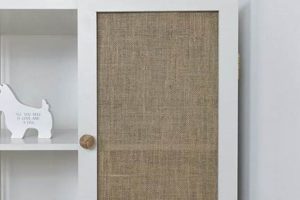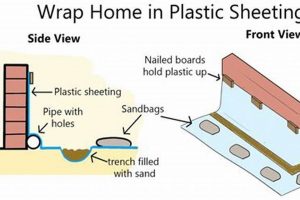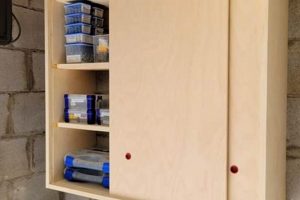A prevalent design choice in cabinetry and furniture making, this particular door style is characterized by a five-piece construction. It comprises a flat center panel surrounded by a frame, typically assembled from four rails and stiles. This construction method allows for both aesthetic versatility and relative ease of fabrication, rendering it a favored option for both professional woodworkers and those undertaking home improvement projects. As an example, a kitchen cabinet front constructed using this method would exhibit clean lines and a recessed panel, offering a timeless and adaptable visual appeal.
The enduring popularity of this door design stems from its simplicity, durability, and adaptability to a wide range of interior design styles, spanning from traditional to contemporary. Its straightforward construction lends itself well to cost-effective production and modification, making it an attractive choice for budget-conscious homeowners and renovation projects. Historically, its roots are traceable to the Shaker movement, which valued practicality and understated elegance, influencing its widespread adoption across diverse applications.
The subsequent sections will delve into the various aspects of constructing such a door, including material selection, joinery techniques, finishing options, and installation considerations. Furthermore, different design variations and customization possibilities will be explored to enable readers to create doors tailored to their specific needs and aesthetic preferences.
Essential Guidance for Shaker-Style Door Construction
The following guidelines are intended to improve the quality and efficiency of constructing a door utilizing the characteristic five-piece design, ensuring durability and aesthetic appeal.
Tip 1: Material Selection: Exercise diligence in selecting appropriate wood species. Hardwoods such as maple, oak, or cherry offer superior durability for high-use applications, while softwoods like pine may be suitable for decorative elements or low-impact areas. Ensure consistent grain patterns within the chosen stock to enhance visual harmony.
Tip 2: Precision in Joinery: Employ accurate measuring and cutting techniques when preparing the rails, stiles, and center panel. Consistent dimensions are crucial for achieving tight-fitting joints. Use a reliable joinery method, such as mortise-and-tenon or cope-and-stick, to ensure structural integrity.
Tip 3: Panel Considerations: Allow for slight expansion and contraction of the center panel within the frame. This can be achieved by using space balls or a similar method to prevent panel cracking or frame distortion due to seasonal changes in humidity.
Tip 4: Glue Application: Use a high-quality wood glue specifically formulated for the chosen wood species. Apply a uniform layer to all joining surfaces, ensuring adequate clamp pressure during the curing process. Wipe away any excess glue promptly to avoid interference with the finishing process.
Tip 5: Sanding Protocol: Employ a progressive sanding schedule, starting with a coarser grit (e.g., 120-grit) and gradually moving to finer grits (e.g., 220-grit or higher) to achieve a smooth, consistent surface. Pay particular attention to corners and edges to remove any sharp transitions or imperfections.
Tip 6: Finishing Application: Prior to applying the chosen finish (e.g., paint, stain, varnish), thoroughly clean the door surface to remove any dust or debris. Apply multiple thin coats of finish, allowing each coat to dry completely before applying the next. This will ensure a durable and aesthetically pleasing result.
Tip 7: Hardware Selection: Choose hardware that complements the style and function of the door. Ensure that the hinges, knobs, or pulls are appropriately sized and securely attached to provide smooth operation and long-term reliability.
These guidelines, when followed meticulously, will contribute significantly to the creation of high-quality doors. The attention to detail in material selection, joinery, and finishing ensures a lasting and visually appealing product.
The concluding section will address common challenges encountered during construction and offer troubleshooting strategies for achieving optimal results.
1. Material Durability
The longevity and structural integrity of a door constructed in the Shaker style are intrinsically linked to the durability of the materials selected. The five-piece construction, characterized by a central panel framed by rails and stiles, subjects each component to stress from everyday use and environmental factors. Inadequate material durability can lead to premature failure of the door, manifested as warping, cracking, joint separation, or finish degradation. For instance, using a softwood such as pine in a high-traffic kitchen application may result in dents and scratches, compromising both its appearance and structural integrity. The initial cost savings associated with less durable materials are often offset by the need for more frequent repairs or replacements. Selecting appropriate wood species is paramount, considering the intended application and anticipated level of wear and tear.
The choice of hardwoods, such as maple, oak, or cherry, offers enhanced resistance to impact, moisture, and temperature fluctuations. This resistance translates to increased stability and longevity, reducing the likelihood of structural defects. Consider the example of a bathroom vanity door constructed with solid oak; its inherent resistance to moisture minimizes the risk of warping or swelling in the humid environment. Furthermore, the selection of durable hardware, such as hinges and pulls crafted from solid brass or stainless steel, contributes to the overall resilience of the door. Conversely, using low-quality hardware can lead to premature failure, even if the door itself is constructed from durable materials.
In summary, the relationship between material durability and this particular style of door construction is causal and direct. Choosing durable materials is a fundamental prerequisite for creating a door that withstands the rigors of daily use and maintains its aesthetic appeal over time. Neglecting this aspect can lead to costly repairs or replacements, diminishing the long-term value of the project. A comprehensive understanding of material properties and their suitability for specific applications is therefore essential for achieving a successful and enduring outcome.
2. Joinery Precision
The structural integrity and aesthetic appeal of a door built with a Shaker-inspired design are inextricably linked to the precision of its joinery. The five-piece construction, a defining characteristic of this door style, relies on accurate and robust connections between the rails, stiles, and center panel. Deviations from precise measurements and execution in the joinery process can compromise the door’s stability, leading to warping, misalignment, or eventual failure. The mortise-and-tenon joint, cope-and-stick joint, and similar techniques employed in its construction demand meticulous attention to detail. Inadequate joinery results in gaps, weak points, and a diminished overall quality, detracting from the clean lines and understated elegance that define the Shaker aesthetic. Consider, for example, a door with poorly executed mortise-and-tenon joints; these joints may loosen over time, causing the stiles to separate from the rails, rendering the door structurally unsound and visually unappealing.
The practical significance of joinery precision extends beyond mere structural considerations. Accurate joinery ensures a flush and seamless transition between the frame components and the center panel, creating a smooth and uniform surface suitable for finishing. Imperfect joints, on the other hand, can create visible imperfections that are accentuated by paint or stain, compromising the final appearance. Moreover, precise joinery facilitates the smooth operation of the door within its frame, preventing binding or sticking. For instance, a door with misaligned joints may rub against the frame, requiring excessive force to open or close and leading to premature wear on both the door and the frame. The selection of appropriate joinery methods is also critical. A cope-and-stick joint, when executed properly, allows for a consistent profile around the inner edge of the frame, enhancing the door’s visual appeal and preventing gaps or unevenness.
In conclusion, joinery precision is not merely a technical detail but a fundamental requirement for a door of this style. It directly influences the door’s structural integrity, aesthetic quality, and functional performance. A commitment to meticulous joinery practices, including accurate measurements, precise cuts, and robust assembly techniques, is essential for achieving a successful and enduring result. The challenges associated with imprecise joinery highlight the need for careful planning, skilled execution, and a thorough understanding of woodworking principles to ensure a door that embodies the timeless elegance and enduring quality associated with the Shaker tradition.
3. Panel Stability
Panel stability represents a crucial element in the successful construction of a door following the Shaker design principles. As the central component within the frame, the panel is susceptible to expansion and contraction due to fluctuations in ambient humidity. This inherent material behavior presents a significant challenge to long-term structural integrity. Insufficient allowance for panel movement can lead to the panel exerting undue force on the surrounding frame, potentially resulting in joint separation, warping, or cracking of either the panel or the frame itself. Consider a solid wood panel tightly fitted within a frame constructed during a period of low humidity; as humidity increases, the panel will expand, placing stress on the frame and potentially compromising its structural integrity. Conversely, a panel that is excessively loose within the frame may rattle or vibrate, detracting from the door’s perceived quality and stability.
Effective strategies for ensuring panel stability involve employing techniques that accommodate dimensional changes without compromising structural integrity. Space balls or similar compliant materials can be strategically placed within the frame’s panel groove to provide a buffer for expansion and contraction. These materials allow the panel to move freely within the frame, mitigating the risk of stress-induced damage. Alternatively, a floating panel design, where the panel is loosely fitted within the frame and secured only by the surrounding structure, can also effectively address this issue. The choice of panel material also plays a significant role; engineered wood products such as plywood or medium-density fiberboard (MDF) exhibit greater dimensional stability than solid wood, making them less prone to expansion and contraction. For example, a door constructed with an MDF panel is less likely to exhibit warping or cracking compared to a door constructed with a solid wood panel of the same dimensions, particularly in environments with significant humidity variations. Careful consideration of panel material and construction techniques is therefore essential for ensuring long-term panel stability.
In summary, panel stability is a critical factor in the construction of a door of this particular style. Addressing potential issues related to expansion and contraction is crucial for preventing structural damage and maintaining the door’s aesthetic appeal over time. Employing appropriate construction techniques, such as using space balls or a floating panel design, and selecting dimensionally stable panel materials are essential steps in ensuring a durable and long-lasting result. Neglecting these considerations can lead to costly repairs or replacements, underscoring the importance of prioritizing panel stability in the construction process. A thorough understanding of material properties and construction techniques is therefore paramount for achieving a successful and enduring outcome.
4. Surface Smoothness
Surface smoothness is a critical attribute directly impacting the aesthetic appeal and functional performance of a door conforming to the Shaker design aesthetic. The clean lines and unadorned surfaces characteristic of this style accentuate any imperfections in the underlying substrate. Irregularities, such as sanding marks, scratches, or uneven filler application, become readily visible, detracting from the door’s overall quality. Consequently, meticulous preparation and finishing techniques are essential to achieving a consistently smooth surface. A failure to adequately address surface imperfections can result in a door that appears unprofessional and fails to embody the understated elegance associated with the Shaker tradition. For example, a door exhibiting visible sanding scratches beneath a painted finish will lack the refined appearance expected of high-quality craftsmanship. Surface preparation, therefore, acts as a foundational step in the creation of a visually pleasing and functionally sound component.
The practical significance of surface smoothness extends beyond aesthetic considerations. A smooth surface provides an optimal substrate for the application of paint, stain, or other protective coatings. Uneven surfaces can lead to inconsistent finish absorption, resulting in blotchiness or uneven color distribution. Moreover, a smooth surface reduces friction, facilitating the smooth operation of the door within its frame. Rough or uneven surfaces can cause binding or sticking, requiring excessive force to open or close the door and potentially leading to premature wear on both the door and the frame. The achievement of surface smoothness necessitates a progressive sanding schedule, employing progressively finer grits of sandpaper to eliminate imperfections and create a uniform texture. The application of a sanding sealer or primer can further enhance surface smoothness by filling minor imperfections and creating a uniform base for the final finish. Skilled application techniques and careful attention to detail are paramount in achieving optimal results.
In summary, surface smoothness is an indispensable element in the construction of a door that adheres to Shaker design principles. Its impact extends beyond mere aesthetics, influencing the door’s functionality and the durability of its finish. Achieving a consistently smooth surface requires meticulous preparation, skilled sanding techniques, and careful application of finishing products. The challenges associated with achieving optimal surface smoothness underscore the importance of prioritizing this aspect in the construction process. The final appearance and performance of the door are directly dependent upon the quality of the surface preparation. A commitment to achieving surface smoothness reflects a commitment to quality craftsmanship and a thorough understanding of the principles underlying the Shaker design aesthetic.
5. Finish Consistency
The achievement of finish consistency is paramount in the fabrication of doors adhering to the Shaker design aesthetic. The unadorned surfaces inherent to this style highlight any irregularities in the finish application, thus rendering consistency a critical determinant of the final product’s visual quality. Inconsistent finish application manifests as variations in color, sheen, or texture across the door’s surface, diminishing its perceived value and deviating from the intended minimalist aesthetic. For example, a door exhibiting blotchy stain absorption or uneven paint coverage disrupts the clean lines and uniform appearance characteristic of well-executed Shaker-style pieces. The absence of finish consistency undermines the overall impression of quality craftsmanship and diminishes the door’s aesthetic contribution to the surrounding environment. Precise control over finish application techniques and environmental conditions is therefore essential for achieving a result that meets the exacting standards associated with this design tradition. The selection of compatible finishing products and the adherence to recommended application procedures are equally crucial in ensuring a uniform and durable final coat.
The practical implications of finish consistency extend beyond mere aesthetics. An inconsistent finish can compromise the protective qualities of the coating, leading to premature wear or damage to the underlying wood. Areas with thinner or uneven finish coverage are more susceptible to moisture penetration, UV degradation, and abrasion, potentially shortening the lifespan of the door. Furthermore, inconsistent finish application can create surface irregularities that accumulate dirt and grime, making the door more difficult to clean and maintain. For instance, a door with an uneven varnish coat may exhibit localized areas of dullness or cloudiness over time, necessitating more frequent cleaning or re-finishing to maintain its appearance. Proper surface preparation, including thorough sanding and cleaning, is a prerequisite for achieving finish consistency. The use of appropriate application tools, such as high-quality brushes or spray equipment, and the maintenance of consistent application techniques are also essential for achieving a uniform and durable finish. Consideration should also be given to environmental factors such as temperature and humidity, as these can significantly impact the drying and curing process of the finish.
In conclusion, finish consistency is an indispensable element in the construction of doors that conform to the Shaker design aesthetic. Its impact extends beyond mere aesthetics, influencing the door’s durability, ease of maintenance, and overall value. Achieving a consistently uniform and durable finish requires meticulous attention to detail, skilled application techniques, and a thorough understanding of the properties of the finishing materials being used. The challenges associated with achieving optimal finish consistency underscore the importance of prioritizing this aspect in the construction process, ensuring that the finished product embodies the timeless elegance and enduring quality associated with the Shaker tradition. Addressing potential issues related to uneven application, inconsistent coverage, and environmental factors is critical for preventing premature wear, maintaining aesthetic appeal, and ensuring a long-lasting and visually pleasing result.
6. Hardware Appropriateness
The selection of hardware for doors adhering to the Shaker design aesthetic is not merely a functional consideration but a critical element in maintaining the integrity of the style. Hardware choices significantly influence both the aesthetic harmony and the operational efficiency of the door. Appropriateness, in this context, refers to the selection of hardware that complements the door’s minimalist design, provides reliable functionality, and withstands the rigors of daily use.
- Style Compatibility
Hardware should align with the understated elegance of the Shaker style. Ornate or heavily embellished hardware detracts from the clean lines and simplicity that define the aesthetic. Instead, simple, unadorned designs in materials such as brushed nickel, matte black, or oil-rubbed bronze are more suitable. For example, using a simple, rectangular knob on a Shaker-style cabinet door maintains the minimalist appeal, while an ornate, antique-style knob would clash with the design. The selection of hardware that complements rather than competes with the door’s design is paramount.
- Scale and Proportion
The size and scale of the hardware must be proportionate to the dimensions of the door. Oversized hardware can overwhelm a smaller door, while undersized hardware may appear insignificant and detract from the overall balance. A large pull on a small cabinet door might seem disproportionate, whereas a small knob on a large pantry door may be difficult to grasp and visually underwhelming. Careful consideration of scale ensures that the hardware complements the door without dominating or diminishing its presence. The ratio of hardware size to door size is a critical design consideration.
- Functional Suitability
Hardware must be suitable for the intended function of the door. Heavy-duty hinges are necessary for larger or heavier doors to ensure smooth operation and prevent sagging. Self-closing hinges may be appropriate for cabinet doors to ensure they close properly. Consider the application: a lightweight cabinet door requires different hinges than a heavy exterior door. Hinges must bear the weight and volume of the door, and the pulls or knobs must be suitable for repeated handling.
- Material Quality and Durability
The materials used in the hardware should be durable and resistant to corrosion and wear. Solid brass, stainless steel, and other high-quality materials ensure longevity and prevent the need for frequent replacements. Inexpensive hardware constructed from flimsy materials may fail prematurely, compromising both the functionality and appearance of the door. Corrosion resistance is critical in environments prone to humidity, and the finish should withstand frequent handling without tarnishing or wearing off. Choosing robust materials ensures a lasting and reliable installation.
In conclusion, hardware appropriateness is a multifaceted consideration that significantly impacts the overall success of doors designed and built in the Shaker style. Careful attention to style compatibility, scale and proportion, functional suitability, and material quality ensures that the hardware enhances rather than detracts from the door’s aesthetic appeal and functional performance. A harmonious blend of form and function is achieved through the thoughtful selection of hardware that complements the door’s minimalist design and withstands the demands of daily use.
Frequently Asked Questions
The following section addresses commonly encountered queries regarding the construction of doors characterized by the five-piece Shaker design. The information provided aims to clarify key aspects of the process and offer practical guidance for achieving optimal results.
Question 1: What is the most appropriate wood species for constructing this type of door to ensure longevity?
The selection of wood species significantly impacts the durability of a door constructed with a Shaker design. Hardwoods, such as maple, oak, or cherry, offer superior resistance to wear and impact, making them suitable for high-traffic areas. Softwoods, like pine, can be used for less demanding applications, but require careful consideration of their inherent vulnerability to dents and scratches. Material selection should align with the door’s intended use and environmental conditions to maximize its lifespan.
Question 2: Which joinery techniques are recommended for securing the frame components of the door?
The structural integrity of the door depends heavily on the joinery methods employed. Mortise-and-tenon joints, cope-and-stick joints, or even high-quality pocket-hole joinery are commonly used for assembling the frame components. The choice of technique should consider the skill level of the builder and the intended load-bearing requirements of the door. Precise execution is crucial for achieving tight-fitting joints that withstand stress and prevent warping.
Question 3: How can one mitigate the risk of panel cracking due to seasonal humidity changes?
Solid wood panels are susceptible to expansion and contraction with fluctuations in humidity. To prevent panel cracking or frame distortion, a floating panel design is recommended. This involves allowing the panel to move freely within the frame without being rigidly fixed. Space balls or similar compressible materials can be used to maintain consistent spacing and prevent rattling while accommodating dimensional changes. Engineered wood products, such as MDF, are less prone to expansion, but might not achieve the desired aesthetic.
Question 4: What is the recommended sanding protocol for achieving a smooth surface prior to finishing?
A progressive sanding schedule is essential for achieving a smooth, paint-ready surface. Begin with a coarser grit sandpaper (e.g., 120-grit) to remove any initial imperfections or milling marks. Gradually progress to finer grits (e.g., 180-grit, 220-grit), sanding in the direction of the wood grain. Consistent pressure and overlap will minimize visible sanding marks. Clean the surface thoroughly between each grit to remove dust and debris.
Question 5: Which finishing products are best suited for achieving a durable and aesthetically pleasing finish on a door built with a Shaker design?
The choice of finishing product depends on the desired aesthetic and level of protection required. Paint, stain, varnish, and lacquer are all viable options. Paint provides a uniform color and excellent coverage, while stain enhances the natural wood grain. Varnish and lacquer offer durable, protective coatings. Apply multiple thin coats, allowing each coat to dry thoroughly before applying the next. Select products specifically formulated for interior or exterior use as appropriate.
Question 6: How should hardware be selected to complement the minimalist aesthetic of the door?
Hardware should be chosen to complement the clean lines and understated elegance of the door. Simple, unadorned designs in materials such as brushed nickel, matte black, or oil-rubbed bronze are typically preferred. The size and scale of the hardware should be proportionate to the door. Functional suitability is also paramount; hinges should be appropriately sized for the door’s weight, and handles should be comfortable and easy to grip. Avoid ornate or overly decorative hardware that detracts from the minimalist style.
These answers provide a comprehensive overview of frequently asked questions concerning the construction of this design. Adherence to these guidelines will contribute to a successful and aesthetically pleasing outcome.
The concluding section will summarize key considerations and provide recommendations for further resources.
Conclusion
This exploration of the diy shaker door construction has underscored the critical interplay between material selection, joinery precision, panel stability, surface smoothness, finish consistency, and hardware appropriateness. Each element contributes significantly to the structural integrity, aesthetic appeal, and long-term durability of the finished product. A thorough understanding of these principles is essential for achieving a successful and enduring outcome.
The enduring popularity of this door style stems from its timeless simplicity and adaptability to diverse design contexts. Careful consideration and meticulous execution, as detailed herein, are paramount for realizing its full potential. Further research into advanced joinery techniques and finishing methods is encouraged to enhance craftsmanship and elevate the quality of future projects. The principles outlined in this discussion serve as a solid foundation for realizing the enduring elegance of a professionally crafted door of this type.







